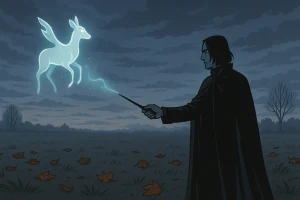What does a single spell say about a character’s deepest secrets? Why does one of the most misunderstood figures in the Harry Potter universe conjure an animal tied not to himself, but to someone from his past? Why does this specific Patronus, graceful, silent, and haunting, redefine everything we thought we knew about Professor Severus Snape?
The reveal of Snape’s Patronus being a doe stands as one of the most emotionally impactful moments in the entire Harry Potter saga. To truly understand it, we must go far beyond the romantic notion of unrequited love and explore what the Patronus charm actually reveals, how it forms, and how it transforms the legacy of one of the Wizarding World’s most complex characters.
What Does a Patronus Represent in the Wizarding World?

The Patronus Charm, known by its incantation Expecto Patronum, is among the most advanced and personal defensive spells in the magical world. It is used to repel Dementors’ soul-sucking creatures that feed on despair, and is rooted in one’s happiest, most powerful memories. But its significance extends far beyond mere protection.
A Patronus reflects the inner self. Unlike a chosen spell or wand movement, a Patronus emerges from one’s subconscious. The strongest form, a corporeal Patronus, manifests as a silvery animal unique to each individual. The creature it takes is shaped by one’s character, emotional core, and defining experiences.
Only highly gifted witches and wizards can cast a full corporeal Patronus, and notably, dark wizards rarely produce one, they are too steeped in dark magic and lack the internal light required.
Furthermore, a Patronus can change following significant life events. Emotional upheavals such as loss, love, or trauma can shift the form entirely.
Why Is Snape’s Patronus So Important?
Snape’s Patronus, a doe, is not just notable because it’s the same as Lily Potter’s, but because of the depth of meaning it carries. When Snape casts the spell in front of Dumbledore in Harry Potter and the Deathly Hallows, it silences any lingering doubts about his true loyalties.
For years, readers and characters alike questioned where Snape’s allegiance lay. He was a Slytherin, a former Death Eater, and deeply antagonistic toward Harry. Yet this single moment recontextualises everything.
Dumbledore, normally composed, is brought to tears, not just because of the form the Patronus takes, but because it reveals the constancy of Snape’s devotion to Lily Potter.
The fact that Snape’s Patronus is a doe proves he never stopped loving her, long after her death. This singular magical image becomes the key to understanding his years of sacrifice, subterfuge, and personal suffering.
Why Does a Patronus Take a Specific Form?
A Patronus is determined by the caster’s personality, emotional connections, and inner truth. Unlike Animagus forms, which can be chosen and mastered, the shape of a Patronus is spontaneous and often surprises even the witch or wizard who casts it.
The animal form acts as a magical mirror. Some Patronuses seem to reflect key character traits, while others are more symbolic, representing emotional bonds or significant memories.
Examples include:
| Character | Patronus | Interpretation |
| Harry Potter | Stag | Connection to his father, strength, nobility |
| Hermione Granger | Otter | Intelligence, playfulness |
| Ron Weasley | Jack Russell | Loyalty, protection |
| Nymphadora Tonks | Wolf (changed) | Reflects love for Remus Lupin |
| Albus Dumbledore | Phoenix | Wisdom, rebirth, uniqueness |
| Minerva McGonagall | Cat | Control, cleverness (same as her Animagus) |
The Patronus form may also evolve. Tonks’s Patronus, for example, changed from a jackrabbit to a wolf after she fell in love with Remus Lupin, a werewolf. This shift reflects how powerful emotions can reshape even the most magical aspects of a person’s being.
Did Snape’s Patronus Always Look Like a Doe?

The books never state whether Snape had a different Patronus earlier in life. This has led fans to speculate whether his Patronus changed after Lily’s death, or whether it always reflected his bond with her.
It’s likely that Snape did not produce a Patronus until later in life. As a Death Eater, he had no need to defend against Dementors. Moreover, Patronus magic requires a strong connection to joy, a feeling Snape rarely experienced. Only after turning against Voldemort, following Lily’s death, might Snape have produced a Patronus for the first time.
Whether the doe was his original Patronus or a transformation caused by trauma, it stands as an eternal reminder of the moment his life was broken, and the decision to dedicate his remaining years to redemption.
Why Is the Doe the Same as Lily Potter’s Patronus?
The most literal explanation is the simplest: Snape loved Lily, and that love was so deeply ingrained in his soul that it manifested magically. Harry confirms this interpretation during his final confrontation with Voldemort, stating,
“Snape’s Patronus was a doe,” he tells Voldemort, “the same as my mother’s, because he loved her for nearly all of his life, from the time when they were children.”
But there is a more layered theory, one grounded in memory. Some fans believe Snape and Lily shared the same Patronus form not because of love alone, but because they both used the same memory to conjure it.
That memory? Their first meeting as children, when Lily discovered she was a witch and Snape, already steeped in magic, showed her a new world. For Lily, it was a moment of self-realisation. For Snape, it was a rare instance of connection and acceptance.
Their shared Patronus may symbolise not romance, but the core moment that shaped them both emotionally and magically.
What Role Does Memory Play in Snape’s Patronus?
The Patronus Charm requires a happy memory, and in Snape’s case, very few qualify. Most of his life was shaped by isolation, abuse, and regret. But the memories Harry views in the Pensieve suggest Snape frequently replayed his early experiences with Lily, the times before everything went wrong.
These are the memories he clung to in the end. As he lay dying, bleeding on the floor of the Shrieking Shack, Snape gave Harry the key to understanding him: his memories, not his words. His Patronus, then, was not cast with pride or heroism but with reflection on the one piece of his past that was not broken.
Was Dumbledore Surprised by Snape’s Patronus?

In one of the most quoted exchanges of the series, Dumbledore reacts to Snape’s Patronus with visible emotion.
“After all this time?”
“Always,” said Snape.
Dumbledore, usually portrayed as all-knowing, appears caught off guard. This suggests he may not have realised the full extent of Snape’s emotional commitment to Lily, or perhaps he did, but witnessing the Patronus made it real.
It’s also possible that Snape had never cast his Patronus in front of Dumbledore before, and the revelation confirmed everything the headmaster had hoped was true about Snape’s motives.
Did Snape’s Patronus Save Harry?
There is an enduring theory that in The Prisoner of Azkaban, when Harry and Sirius are attacked by Dementors, the first Patronus to appear is not Harry’s, but Snape’s. This Patronus arrives before Harry time-travels to cast his own.
While the books leave it ambiguous, the idea adds further depth to Snape’s quiet role in Harry’s life. It wouldn’t be the last time Snape acted in secret to protect Lily’s son.
Does a Shared Patronus Always Mean Romantic Love?
Not necessarily. Although romantic relationships can influence Patronus forms, they are not exclusive to such bonds. In the case of Snape and Lily, their connection was emotional, formative, and profound, but not reciprocal in a romantic sense.
It’s more accurate to say that their Patronuses represent a shared emotional cornerstone, a memory or feeling so deeply etched into their beings that it defines their magical expression.
What Does Snape’s Patronus Reveal About His Legacy?
Snape’s Patronus tells a story of:
- Loyalty without reward
- Love without condition
- A life shaped by one irreversible moment
While Snape was never perfect, his cruelty towards students and contempt for Harry remain troubling, his Patronus proves that beneath his bitterness lived a man with depth, emotion, and honour.
Dumbledore once said it is our choices that define us more than our abilities. Snape made his choice. He chose to protect, to atone, and to love, even without hope of forgiveness.
Conclusion: What Does It Mean That Snape’s Patronus Was a Doe?
The doe stands not only as a reflection of Lily Potter, but also as a symbol of eternal devotion, memory, and quiet heroism. It is the embodiment of Snape’s inner life, one shaped by pain but defined by love.
It is not a romantic ending. It is not a happily-ever-after. But it is something deeper. It is “Always.”
FAQs
Can a Patronus change form?
Yes. A Patronus can change after a significant emotional event, such as falling in love or suffering a loss.
Did Lily’s Patronus change to match James’s?
There is no evidence of this. It is more likely that her Patronus was always a doe, representing her identity, not her relationship.
Did Snape cast a Patronus before Lily’s death?
Unclear. The books never mention one before her death, and his emotional state prior to turning on Voldemort may not have supported it.
Why couldn’t Voldemort cast a Patronus?
Dark wizards rarely cast Patronuses. They rely on dark magic, and the Patronus requires a pure, hopeful state of mind.
Did Harry’s Patronus reflect love or lineage?
Both. His stag Patronus connects to his father, but also represents protection and his own character.
Could Snape have had another Patronus before the doe?
It’s possible, but unconfirmed. The doe may have been his first, born from tragedy and love.
Is the Patronus the best proof of Snape’s redemption?
Yes. It’s a deeply personal spell, impossible to fake, and it revealed his most vulnerable truth.






